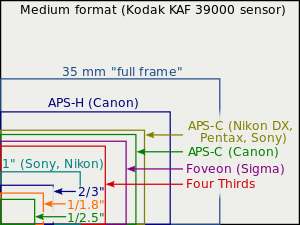Speak personally, following the series of messages related to camera image sensors, in this post I will write about the main image sensor sizes of photography, video and cinema cameras.I have already published several articles related to image sensors here on the eMania blog, which also provides a lot of information in the main areas of audiovisual (photography, video and cinema). You can read the following articles: MEDIA AND CINE OBJECTIVES, THE IMAGE SENSOR AND WHAT IS THE DIFFERENCE BETWEEN CMOS AND CCD ?Image sensor sizes in some cameras.
On the market, there are many models and camera sizes for photography, video and cinema, with a variety of image sensor sizes. The size of the image sensors influences several factors in an image, quality, depth of field, among others.others I will describe in this post Here are two tables with the size of the camera sensors as well as the cinema cameras:
The sizes of the camera image sensors
Image sensor sizes will determine the quality of the image to be produced, the larger the image sensors, the more pixels, and the higher the image quality.In cameras, the main sizes are: full format, APC-H, APS-C and four thirds, as you can see in the following table:
The sizes of image sensors for film and video cameras.
Video and digital cinema cameras have different image sensor sizes the size of the camera image sensors, as you can see in the following table:
A bit of history of the references used to define the size of the image sensors.When the first CCD sensors were created in the 1970s, their different sizes were standardized to the same dimensions as those used by their ancestors, Visdicom tubes, respecting lens compatibility..
I’ll make a comparison of two specific camera image sensor sizes and compare Full Frame with APS-C.I chose these image sensor sizes because they are very close to the image sensor sizes of cinema cameras.Before I start making the comparison, I want to talk a little bit about the history of the full frame sensor size.The sensor has a size of 24 x 36 mm and a height/width ratio of 3: 2, inherited from DSLR cameras using 35 mm films with the same dimensions 24 x 36 mm.When cameras switched from analog to digital, the manufacturers of the early DSLRs had several difficulties in producing a 35mm film-sized image sensor, so they opted for a smaller, easier-to-produce image sensor, offering sufficient quality for the time and for most photographers.Image Sensor (APS).
The Advanced Photo System (APS) were created by a group of companies, Canon, Nikon, Kodak, Fujifilm, Pentax and Minolta.Of course, each of these companies has created its own model.Below, you can see the variation in sizes.APS (Advanced Photo System):
Now I’m going to make a comparison between the full frame image sensors and APS, showing the pros and cons of each.The advantages of a full-size image sensor over an APS image sensor are numerous, starting with the quality and definition of the image as I mentioned above, but here are some of these advantages:
Full Frame
APS (Advanced Photo System):
That is, my dear friends, in the next post, I will talk about the main camera models used in digital cinematography and tell a little about the story of the choice of digital format by cinema.
Hugs to all !!!!

